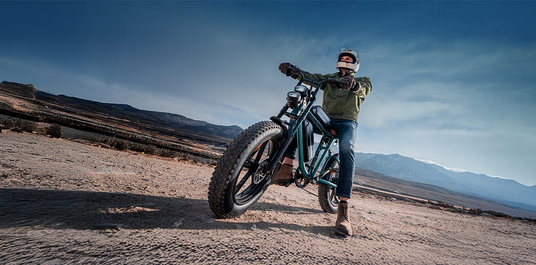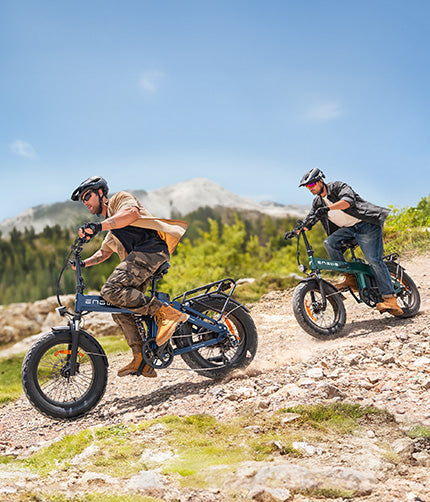The long-range e-bike is the promise of freedom. It’s the freedom to explore more, to commute to and from without the burden of a nagging low-battery warning, and to turn a short ride into a daylong affair. But for most riders who aspire to take to the road in Europe, the phrase "long range" is buried in marketing hype and puzzling technicalities. You notice there’s a mileage mentioned and perhaps there are different ranges, perhaps 100km or 120km, but behind all this, one question is foremost on your mind: “Will it really go that far for me?” And that, in essence, is what has come to be called ‘range anxiety’—and this guide aims to dispel it. We’re going to cut through the noise and give you the key concepts you need to know to understand what really makes a long-distance electric bike, to do so with confidence, and to make a decision for the companion of your journey that will never leave you dead next to the road for lack of juice.
What "Long Range" Really Means (Behind the Advertised Km)
Let’s begin by stating a crucial reality right up front: the range listed for any e-bike is an ideal-case scenario. It’s a number that is reached under ideal conditions, such as when tested with a lightweight rider on flat, smooth terrain in the lowest level of pedal assistance (PAS)—no hills, no wind resistance, and no carrying a second passenger on the rack. The actual range in the real world will most likely be different. Why? Because an e-bike’s range isn’t a fixed figure; it’s a dynamic outcome that depends on a whole number of factors. Once you understand the variables, the next step is an educated decision.
Battery Capacity is Key
The most important factor of all is the power capacity of the battery, measured in Watt-hours (Wh). That's your "fuel tank," full stop. For this, you just multiply the Voltage (V) and the Amp-hours (Ah) of the battery. For instance, a 48V 13Ah battery boasts 624Wh. The bigger the Wh, the more juice you store, the farther you could potentially travel.
The Rider’s Input
Weight matters, as does your pedaling style. It requires more energy to propel a heavier rider. Conversely, if you use the motor a lot and pedal less, you deplete the battery faster. An e-bike is meant to help you, not do all the work for you. The more you give, the more you receive.
The Ride Itself
Rolling along on a flat, smooth bike path in fair weather is a lot easier than slogging up steep hills against fierce winds. Terrain determines the motor’s workload. The frequent stopping and starting in city traffic also burns more electricity than a steady cruise in the countryside.
Environmental Conditions
Nothing wrecks a battery like cold temperatures. When it is winter, you should expect range drops between 20-30% due to the fact that the chemical reactions that take place in the battery slow down. Tire pressure is also crucial. Inflate your tires properly—tires with too little air are less efficient and will cost you range.
The Key Factors That Determine The Range Of Your Electric Bicycle
So now that we know the variables, what does the hardware look like? There are three main elements of a long-range e-bike: the battery, the motor, and the tires.
The Battery
Watt-hours are the final measure, as we said. For a bike to be classed as “Long Range,” start searching for a bike with a battery of at least 500Wh. Anything above 600Wh is excellent. A removable battery is also important for many European users. That offers two huge benefits: safety and convenience. You can bring that most valuable part inside to charge, out of the cold and away from potential thieves, while you park your bike outside.
The Motor and Sensor
E-bikes are restricted to a 250W continuous power output in Europe. Hence, motor efficiency is more valuable than absolute power. Efficiency, too, is in the sensor. Less expensive bikes have a cadence sensor that merely turns the motor on when you pedal. A superior system (which you should hunt down if you want a smooth ride) is the torque sensor. A torque-sensor system determines how hard you are pedaling and provides assistance that is proportionate. This is much more natural, as if your very strength were being augmented, instead of simply mimicked, and it’s also vastly more efficient, conserving precious battery reserves by only providing as much assistance as you truly require.
Tires and Drivetrain
There is a trade-off with the tire choice. This way, you get a slick, narrow tire that rolls over the asphalt with less resistance, helping you achieve the best possible range. But fat tires—4.0 inches wide—also provide tons of comfort and stability and are capable of traversing everything from cobblestones to gravel roads to sandy trails. For most riders, the small loss of theoretical range is more than worth it for the go-anywhere ability combined with a plush ride. A good drivetrain, such as a Shimano 7-speed, can help with this, keeping you in the right gear and putting less strain on both your legs and motor.

WHEN AN E-BIKE IS, PRACTICALLY, FOR YOU: Matching Your E-Bike to Your Ride
Not all long-range e-bikes are one-size-fits-all. The perfect fit is simply based on your primary use case.
Best for the Urban Commuter and Delivery Professional
You know what you want—reliability—and you’ll pay for it. Your daily trek might mean hauling loads, navigating city streets, climbing and descending hills, and making a dash to work—a utilitarian exercise rather than a leisurely roll. For you, the key features will be a high load capacity, a sturdy rear rack, powerful brakes for safety in stop-and-go traffic, and, maybe, a design that folds up for convenient storage in an apartment or office.
For the Weekend Explorer and Leisure Rider
Your rides are all about enjoying and experiencing the surroundings. You might be trekking down country lanes, a coastline ramble, or a forest trail. Comfort is paramount. What you need is a bike that can soak up the bumps, elevates the ride and the display, and won’t give you range anxiety if you decide to take a scenic detour that piles on a lot of miles and takes you well past your drop-dead distance from home.
For the All-Terrain Adventurer
You can’t be confined by pavement. Your e-bike must be durable and adaptable—able to take on any terrain. You’ll need fat tires, the better for gripping and cushioning on unpaved roads, dirt tracks, and maybe even sand. A sturdy body and sturdy materials are an absolute must, to ensure your electric bike can handle the bumpy trails.
A Few Detailed Perspectives about an All-round e-Bike: ENGWE EP-2 BOOST
It's time to take a closer look at the ENGWE EP-2 Boost electric bike for those looking for an electric bike in Europe that offers decent range but not at the expense of features. It has been carefully designed to satisfy the essential needs of a rider, effortlessly merging long-range capability with cross-country agility as well as urban versatility. Central to this is the robust 48V 13Ah removable lithium-ion battery, more than capable of up to 120km in PAS 1 mode, meaning range anxiety will not affect any but the most far-flung of journeys. The riding experience and efficiency come from its sophisticated torque sensor. This intelligent system delivers a smooth, natural, and pleasant power assist experience that feels like it's a part of you, maximizing battery life while providing extra power where you need it. In the face of any steeper stuff, a mild tap of the Boost button unleashes the full 55Nm of torque from the EU-legal 250W motor, and hills can promptly be tackled with ease. The EP-2 Boost doesn’t just reach far; it’s also a tank. 20-inch x 4.0-inch fat tires on all-terrain (one-piece) wheels deliver great stability and comfort on all surfaces from smooth to rough. For city slickers, it can’t be beaten with its fold-away frame to conveniently stow and go. Safety is also a priority, which is why the EP-2 Boost features strong 180mm front and rear Tektro disc brakes, a robust rear rack, fenders, and a simple-to-read LCD display. By no means is the ENGWE EP-2 Boost a “one-trick pony”; this bike does it all. It's your all-in-one long-range e-bike.

How to Get the Most Out of Your E-Bike’s Battery
It all starts with having an awesome long-range e-bike. The second is knowing how to stretch every single charge. Here are some pro tips:
1. Use the Gears, Not Just the Motor
Utilize your Shimano gears like you would on a regular bike. Downshifting on hills saves a lot of energy by taking the pressure off the motor.
2. Keep Tires Properly Inflated
You should check your tire pressure once a week. Riding on under-inflated tires is comparable to riding through mud—it’s a very high rolling resistance and an unnecessarily high drain on your battery.
3. Glide
Don’t jackrabbit or stop short. A smooth and steady cadence is the most efficient pedaling technique.
4. Select a Lower PAS Level
Try to program a habit of using the lowest possible assisting level you can. Reserve the higher assistance levels for hills or when you want to go really fast.
5. Travel Light
Extra weight is going to add extra work for the motor. If you don’t have to have it on your trip, leave it at home.
6. Care for Your Battery
Keep your battery indoors in a room-temperature location. Don’t keep it fully charged or allow it to drop to 0% for long periods. For long-term storage, shoot for about a 60-80% charge level.
Let this information be your guide. Armed with the right knowledge and, of course, the perfect electric bike, your next adventure is now absolutely at your fingertips.

Frequently Asked Questions (FAQs)
1. Would a larger (Watts) motor work better for longer range?
Not really. It's certainly not the case in Europe, where the legal continuous output is 250W. It's all about motor efficiency. A quality-built 250W motor with a torque sensor will often give you better range than a poorly-conceived 36V 500W motor because it uses energy more wisely.
2. Cold weather and my e-bike’s range: How big is the impact anyway?
The impact is significant. Lithium-ion batteries do not work as well in the cold. You can expect a range loss of 20-30%, or even more on a very cold day. Keeping your battery indoors and charging it at room temperature can help mitigate this.
3. What is the key reason for having a torque sensor instead of a cadence sensor?
A torque sensor measures how hard you are pedaling, which feels incredibly natural, responding in proportion to your pedaling force. It is also, by nature, more efficient, and only gives you the power you need. A cadence sensor is pretty much a simple on/off switch; when you’re pedaling, it makes sure the motor is on at whatever preset level you’ve selected, which can feel jerky and is less efficient with the battery.
4. Can I get a bigger battery later to increase my e-bike’s range?
Yes, often, but you'll need to make sure that the new battery is 100% compatible with your bike's model, voltage, and controller system. It is always best to buy from the original manufacturer for safety and compatibility reasons.
5. Would fat tires be a poor choice if I'm looking for the most range I can get?
It's a trade-off. Narrower tires will be faster and you will get a tiny bit more range on perfectly smooth pavement. But fat tires offer better comfort, stability, and the ability to tackle all manner of terrain. For most riders, this freedom-to-roam-anywhere and smooth ride feel is worth a small sacrifice in maximum potential range.









